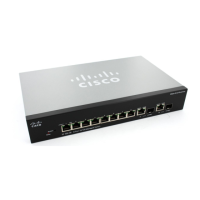Configuring IP Information
Management and IP Interfaces
Cisco Small Business 300 Series Managed Switch Administration Guide 171
15
If a dynamic IP address is retrieved from the DHCP server, select the following
fields that are enabled:
• Renew DHCP Address—The switch dynamic IP address can be renewed
any time after it is assigned by a DHCP server. Depending on your DHCP
server configuration, the switch might receive a new IP address after the
renewal that will cause a loss of connectivity to the web-based switch
configuration utility.
• Auto Configuration via DHCP—Displays status of auto-configuration
feature. You can configure DHCP Auto Configuration from
Administration
>
File Management
>
DHCP Auto Configuration
.
STEP 3 Click Apply. The IPv4 interface settings are defined, and the switch is updated.
Defining IPv4 Interface when the Switch is in Layer 3 Mode
The IPv4 Interface Page is used when the switch is in Layer 3 mode. This mode
enables configuring multiple IP addresses for switch management, and provides
routing services.
The IP address can be configured on a port, a LAG, or VLAN interface.
Operating in Layer 3 mode, the switch routes traffic between the directly attached
IP subnets configured at the switch. The switch continues to bridge traffic
between devices in the same VLAN. Additional IPv4 routes for routing to non-
directly attached subnets can be configured in the IP Static Routing Page.
NOTE The switch software consumes one VLAN ID (VID) for every IP address configured
on a port or LAG. The switch takes the first VID that is not used starting from 4094.
To configure the IPv4 addresses:
STEP 1 Click IP Configuration > Management and IP Interface > IPv4 Interface. The
IPv4 Interface Page opens.
This page displays the following fields:
• Interface—Interface for which the IP address is defined.
• IP Address Type—IP address defined as static or DHCP.
- Static—Entered manually.
- DHCP—Received from DHCP server.
• IP Address—Configured IP address for the interface.

